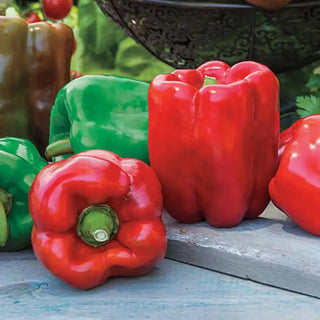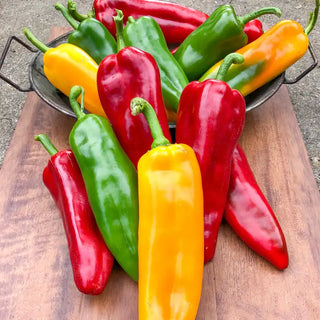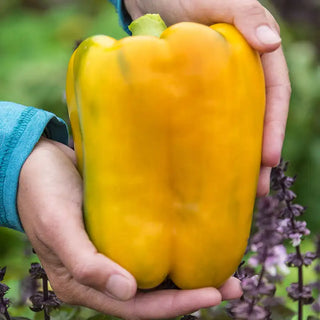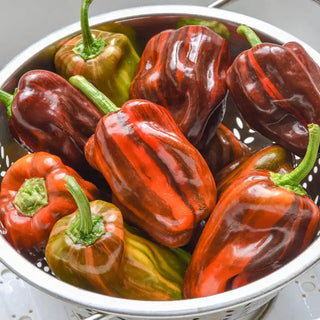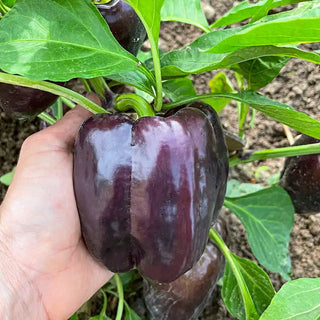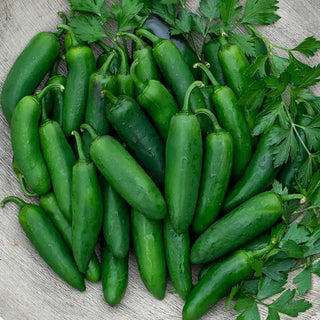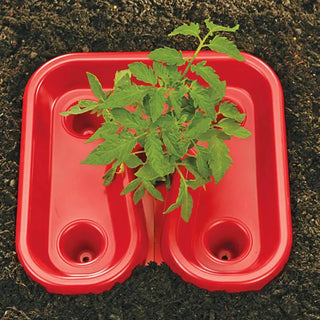Sweet pepper plants are colorful, crisp, flavorful, and a favorite choice among gardeners. Whether you are a seasoned gardener or just dipping your toes into the world of gardening, we have something special for everyone. Our range of sweet pepper plants is ready to add a splash of color and a burst of flavor to your garden and dishes.
Sweet Pepper Plants From Gurney's
Easy to grow, nutritious and so easy to incorporate into salsas, salads and other recipes, sweet peppers are a top choice among gardeners. Gurney's carries a wide selection of sweet peppers including banana, sweet bell, cubanelle and mini bells. At Gurney's, we grow a wide variety of sweet peppers in our test gardens--so our sweet pepper seeds for sale and sweet pepper plants for sale represent the best in taste, garden performance and productivity. Generations of gardeners have trusted Gurney's to supply the best varieties and top-quality sweet pepper seeds and plants.
How to Choose the Right Sweet Pepper Plants
Before choosing sweet pepper plants, take into account your gardening site. Sweet pepper plants perform best when they receive at least 6-8 hours of direct sunlight daily and are planted in well-drained soil. Sweet pepper plants can be grown in the garden, raised beds, containers or Grow Tubs. If you have limited space or are growing sweet pepper plants in containers, consider more compact varieties. Next consider how you want to use your sweet peppers. Because they're available in a wide variety of shapes, colors and flavors, many gardeners grow several varieties of sweet pepper plants.
Gurney's offers both sweet pepper seeds for sale and sweet pepper plants for sale. If growing a lot of sweet pepper plants, then it's often most economical to buy sweet pepper seeds and start the plants indoors; if you want to try just a few plants or a few plants of different varieties, then buying sweet pepper plants is a convenient option.
Getting Started with Growing Sweet Pepper Plants
Sweet peppers are a warm season vegetable, and most gardeners start sweet pepper seeds indoors in the spring and then transplant the seedlings to the garden. Others buy pepper plants and plant them in the garden once the danger of frost has passed.
When to Plant Sweet Peppers
Plant pepper plants outdoors after the last spring frost when the soil temperature reaches at least 60°F.
How to Plant Sweet Peppers
Plant sweet pepper seeds indoors 8-10 weeks before the last frost, then transplant seedlings 18-24 inches apart in full sun.
How to Grow Sweet Pepper Plants
Water regularly to keep the soil moist but not soggy, provide at least 6-8 hours of direct sunlight daily.
How to Care for a Sweet Pepper Plant
Water regularly, about 1-2 inches per week, and apply a balanced fertilizer every 4-6 weeks. Monitor for pests and diseases and use mulch to retain soil moisture and control weeds.
Frequently Asked Questions About Sweet Peppers
How Tall Do Sweet Pepper Plants Grow?
While sweet pepper plants vary in size depending on their variety and growing conditions, most sweet pepper plants grow 18-36 in. tall.
How Often To Water Sweet Peppers?
Sweet pepper plants should receive 1-2 inches of water weekly. If the plants are mulched, then less water may be needed. Hot weather may increase watering needs.
How Long Do Sweet Peppers Take to Grow?
Sweet peppers generally mature and bear fruit in less time than hot peppers. The time it takes from transplanting to the garden to maturity varies, but is generally 2-4 months, depending on the variety and the weather conditions.

